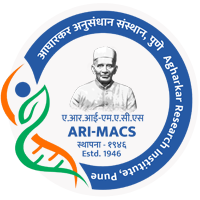
Google Scholar / Social Media
Name : Dr. Suresha P G
Designation : Scientist – B
Brief Background :
The use of soybean dates back to the beginning of China’s agricultural age. The utilization of this crop has been mentioned in Chinese medical compilations dating back 6000 years. Area under soybean cultivation is rapidly expanding partly due to its high nutritional value as food for both humans and livestock and as an important industrial crop. It is considered as a ‘Golden bean’ or ‘miracle bean’ due to its dual qualities viz; high protein (40%) and oil (18–20%) content. It is grown on approximately 250 million ha throughout the world.
Soybean being the richest, cheapest and easiest source of best quality proteins and fats and having a vast multiplicity of uses as food and industrial products is sometimes called a wonder crop. Soybean builds up the soil fertility by fixing large amounts of atmospheric nitrogen through the root nodules, and also through leaf fall on the ground at maturity. It can be used as fodder; forage can be made into hay, silage etc. Its forage and cake are excellent nutritive foods for livestock and poultry
Contact Details :
+91 9901431990
- B.Sc. in Agriculture
- M.Sc. (Agri), University of Agricultural Sciences, Raichur, Karnataka. (Specialization: Genetics and Plant Breeding)
- Ph.D. (Agri.), University of Agricultural Sciences, Dharwad, Karnataka.
- Ph.D. thesis title: Genetic analysis for resistance to rust in soybean (Glycine max (L.) Merrill)
- Assistant Professor (Contract), at Dept. of Genetics and Plant Breeding, Keladi Shivappa Nayaka University of Agricultural and Horticultural Sciences, Shivamogga from 09-09-2019 to 04-06-2022
- Qualified for National Eligibility Test conducted by ICAR-ASRB
- Collection and evaluation of exotic germplasm lines from different institutes for biotic and abiotic stresses.
- Pre-breeding and germplasm enhancement using the cultigen as well as wild species.
- Evaluation and establishment of a core collection of soybean genetic resources.
- Development of short duration varieties maturing within 85-90 days suitable for intercropping with sugarcane and sequence cropping systems.
- Speeding up the development of new varieties through use of single seed descent and off-season nursery to shorten the time for development of varieties.
- Molecular breeding in soybean.
- DNA molecular markers for molecular tagging and mapping of economic traits and marker aided selection for speeding up the breeding work for biotic stresses and abiotic stresses.
- Breeding for vegetable type soybean through conventional and biochemical approach.
- Anti-nutritional factors such as Kunitz trypsin inhibitor and lypoxygenase are major challenges in quality breeding of soybean to convine the public to accept soybean as food crop.
Recognition:
- Identified a new source of rust resistant exotic germplasm line (EC 242104) in soybean which can be further utilized in hybridization Programme.
- Two genetic stocks, DHKN 509 and DHKN 563 with high kernel rows in maize have been submitted for registration with PPV-FRA.
Publications list:
- P.G. Suresha, Vikas Kulkarni, I. Shankergoud, M. R. Govindappa and R. Lokesha, 2016, combining ability analysis for seed yield, component traits and powdery mildew tolerance in sunflower (Helianthus annuus L.). Eco. Env. & Con., 22: S225-S230.
- P.G. Suresha, Vikas Kulkarni, S. M.Supriya, S. Darshan, and Chandrashekar B. Patil, 2017, Genetic diversity analysis in sunflower (Helianthus annuus L.) parental lines using SSR and RAPD markers. Int. J. Curr. Microbiol. App. Sci., 6 (7): 2069-2076.
- P. G. Suresha, Vikas V. Kulkarni, Govindappa, M. R. and Supriya S. M., 2017, Evaluation of experimental hybrids for powdery mildew tolerance in sunflower (Helianthus annuus L.). Int. J. Curr. Microbiol. App. Sci., 6 (7): 2716-2728.
- S. M. Supriya, Vikas V. Kulkarni and P. G. Suresha, 2016, Screening of sunflower genotypes against powdery Mildew. The Bioscan, 11 (4): 2991-2996.
- S. M. Supriya, Vikas V. Kulkarni and P. G. Suresha, 2017, Inheritance of powdery mildew resistance in sunflower (Helianthus annuss L.). J. App. Natural Sci., 9 (3): 1358-1364.
- S. Darshan, P.G. Suresha, R.U. Priya and K. Arya, 2016, Wrky Transcription Factors: Trends in Crop Improvement. Advances in Life Sciences, 5 (11):4344-4346.
- Vikas V. Kulkarni, I. Shankergoud, Supriya S. M. and Suresha P.G., 2016, Correlation studies of SSR marker based genetic distance and Heterosis in Sunflower (helianthus annuus L.), iSC, Proceedings of 19 th International Sunflower Conference 29 May – 3 June, EDIRNE, TURKEY.
- Supriya, S.M., Vikas V. Kulkarni, Ranganatha, C. N. and Suresha, P.G., 2017, Quantitative Analysis of Oil Yield and Its Components in Newly Developed Hybrids of Sunflower (Helianthus annuus L.), Int. J. Curr. Microbiol. App. Sci., 6 (8):3088-3098.
- Suresha, P. G. and Basavaraja, G. T., 2019, Genetic diversity studies in exotic germplasm lines for yield related traits in soybean (Glycine max (L.) Merrill). International Journal of Chemical Studies, 7(4): 2066-2071.
- Shobha Immadi, Basavaraja, G.T. and Suresh, P.G., 2021, Genetic Enhancement and Genetic Analysis of Resistance to Asian Soybean Rust in India. Legume Research, 10.18805/LR-4345.
- P. G. Suresha, G. T. Basavaraja, Harshiya Banu, Shamarao Jahagirdar, Gyanesh Kumar Satpute. and Sanjay Gupta, 2020, Identification of New Source for Resistance to Rust in Exotic Germplasm Lines of Soybean (Glycine max (L.) Merrill). Soybean Res., 18 (2): 1-15.
- G.T. Basavaraja, B. S. Gill, Harshiya Banu, G. K. Naidu, Shalini N Huilgol and P.G. Suresha, 2021, A promising multiple disease resistant genotype in soybean. The Pharma Innovation J., 10(11): 1364-1369.
Awards/ Medals received:
- Best Oral Presentation Award from National Conference on Genetics & Cytogenetics, UAS, Dharwad on 1-2 February, 2018.
2. Young Achiever Award-2020 from Society for advancement of human and nature (SADHNA), Dr YS Parmar University of Horticultural and Forestry, Nauni, Solan-173 230, Himachal Pradesh.
3. Qualified for National Eligibility Test conducted by ICAR-ASRB



